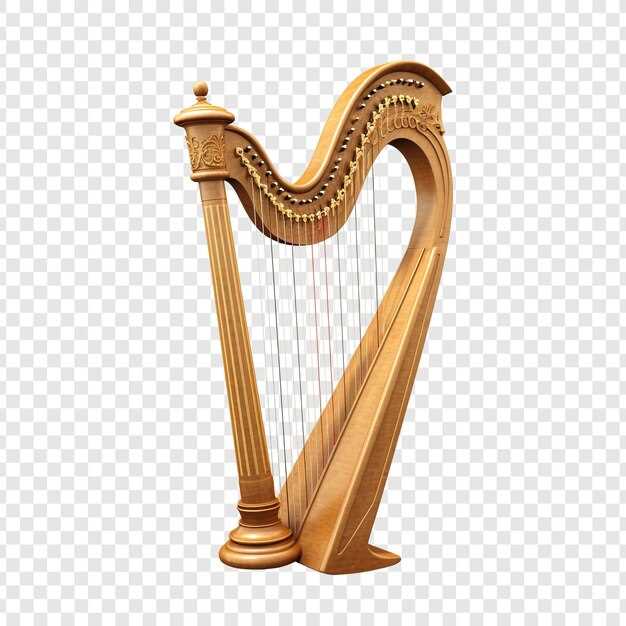For aspiring musicians seeking a resonant instrument with roots stretching back millennia, consider exploring the varied forms of the *lyre*. From the seven-stringed *kithara* favored in ancient Greek performance to the smaller, more portable *simsimiyya* still played in parts of East Africa, a diversity of designs exists, each offering unique sonic properties.
Mastering this instrument begins with understanding its construction. Observe the *chelys*, crafted with a tortoise shell resonator, unlike the box-shaped sound box of a *barbiton*, preferred for its lower tonal register. The number of strings, typically ranging from seven to ten in classical instruments, affects the available musical scales.
The method of string activation also dictates the tonal character. Ancient players primarily employed a plectrum for strumming or single-note articulation, as depicted in numerous vase paintings. Contemporary performers often experiment with fingerpicking methods to achieve richer harmonic textures. Exploring various tunings, like the Dorian or Phrygian mode, expands the melodic possibilities beyond conventional diatonic scales.
Origins and Evolution
Confirming the instrument’s precise genesis remains challenging due to limited archaeological confirmation. Proto-harps present on Sumerian artifacts (c. 3200 BCE) offer potential early examples. Early Greek depictions (Mycenaean period, c. 1400 BCE) showcase instruments with fewer strings (typically 4-7) than later models. These simpler forms may have served primarily for rhythmic support or melodic contouring.
Significant diversification occurred during the Greek Classical period (c. 5th century BCE). The *kithara*, a larger, heavier instrument, became associated with professional musicians and dramatic performances. Conversely, the *lyra* itself, typically smaller with gut strings, remained popular for personal use, education, and religious ceremonies. Sources mention varying numbers of strings, often between 7 and 11, affecting melodic capabilities.
Roman adaptations followed Greek patterns, incorporating construction variations (e.g., use of different woods, bone ornamentation). The instrument saw usage in both public spectacles (gladiatorial contests) and private gatherings. Later, its presence diminished in Western Europe, influenced by the rise of other stringed instruments. In contrast, in Eastern Africa, variations persisted, demonstrating regional adaptation and cultural importance. The *krar* in Ethiopia exemplifies such enduring modifications.
Examining construction techniques reveals gradual shifts. Early instruments used tortoise shells or wood for resonators, later examples incorporate elaborate soundboxes for amplified projection. String materials (gut, linen, silk) influenced tone quality. Bridges, initially simple supports, evolved in shape to affect string spacing and vibrational characteristics.
Variations Across Cultures
Greek kithara used a tortoise shell soundbox, unlike the Sumerian kinnor which employed a rectangular wooden frame. Kithara strings were plucked with a plectrum for greater projection, while kinnor strings were often strummed or lightly plucked.
East African endongo, frequently constructed from lightweight wood and antelope skin, features a pentatonic scale. This contrasts with the heptatonic scales common to many reconstructions of ancient Greek instruments.
Ethiopian beganna, considered sacred, uses ten strings tuned diatonically. Its sound production relies significantly on finger damping, affecting timbre. Performances often accompany religious ceremonies and narratives.
Welsh crwth, though technically a bowed stringed instrument, shares structural similarities with some box instruments. Unlike plucked instruments, the crwth’s bridge extends through the soundbox, directly contacting the back for increased volume.
Germanic harp-instruments during the Migration Period frequently possessed fewer strings (4-7) than contemporary Mediterranean kitharas. Bone or antler pegs were used for tuning, showing distinct material choices.
Producing Sound: A Practical Guide
For a clear tone, pluck strings near the soundhole, approximately one-third of the string length from the bridge. This minimizes unwanted overtones. Experiment with different finger pressures; lighter pressure yields a softer sound, while firmer pressure produces a louder, brighter tone.
String Material and its Impact
Gut strings offer a warm, mellow sound, suitable for historical performance practice. Nylon strings provide greater durability and are less susceptible to pitch fluctuations due to humidity changes. Steel strings project a louder, brighter tone, favored in contemporary musical settings. Consider string gauge: thinner gauges vibrate more freely, producing a brighter sound, but may be less robust. Thicker gauges offer greater volume and projection, but might feel stiffer under the fingers.
Amplification
If amplification is required, consider using a small diaphragm condenser microphone placed 6-12 inches from the resonating chamber. For a more portable option, a magnetic pickup can be installed, capturing string vibrations directly. Experiment with placement for optimal sound capture and feedback reduction.
Q&A:
The article mentions several types of lyres. Could you explain more about the differences in construction between, say, a Greek *kithara* and a Germanic lyre? What aspects affected their sound or playing style?
The Greek *kithara* and the Germanic lyre, although both stringed instruments held in the lap or against the body, differed significantly in their construction, influencing both sound and technique. The *kithara* generally featured a larger soundbox, often made from a turtle shell or wood, with arms extending upward and connected by a yoke. The strings were typically gut and stretched from the soundbox over a bridge to the yoke. This construction, particularly the larger soundbox, contributed to a fuller, richer tone suitable for accompanying vocals and epic poetry. The Germanic lyre, or *crwth*, often had a rectangular frame that served as both soundbox and structure, typically carved from a single piece of wood. Its strings, also typically gut, were attached directly to the frame. The smaller soundbox and simpler construction resulted in a brighter, perhaps less resonant sound. The way the strings are attached and the lack of a pronounced bridge also influenced playing style. The *kithara* seems to have often been plucked with a plectrum, allowing for more precise melodies, while the Germanic lyre was often strummed or plucked with fingers, providing rhythmic accompaniment or drone notes alongside melodies. The difference in the number of strings also contributed to the complexity of the music which can be played.
The article touches on playing techniques. Are there surviving sources that detail specific methods for tuning or playing lyres in antiquity, or is our understanding primarily based on iconography and surviving instruments?
Our understanding of ancient lyre tuning and playing techniques comes from a combination of sources, but explicit, detailed instruction manuals are rare. We rely on iconography (depictions on vases, sculptures, and frescoes), surviving fragments of instruments, and textual references within literature. Iconography provides visual clues regarding hand positions, plectrum use, and how the instrument was held. Surviving instrument pieces allow researchers to analyze string length and placement. Textual references offer hints. For example, some Greek writings discuss musical scales and modes, indirectly informing our understanding of how lyres were tuned to produce those scales. However, reconstructing precise tuning methods and fingering techniques is a complex process involving scholarly interpretation and experimental archaeology. Modern musicians who construct and play replicas often experiment with different tunings and methods to gain a deeper awareness of the instrument’s capabilities and potential.
Beyond ancient Greece and Germanic cultures, did other civilizations develop or adapt the lyre? Were there any unique regional variations in design or playing styles I could research?
Yes, the lyre was present in various forms across numerous cultures beyond Greece and the Germanic regions. For instance, lyre-like instruments have been discovered in ancient Mesopotamia (present-day Iraq), such as the bull-headed lyres of Ur. These instruments often featured elaborate decorations and distinct construction compared to their Greek counterparts. In eastern Africa, various lyre traditions exist to this day, such as the *krar* in Ethiopia and Eritrea. These instruments frequently have smaller resonators and unique tuning systems reflecting local musical scales. Exploring these diverse musical cultures reveals regional variations in design, materials, and playing styles. Researching Mesopotamian archaeology, Ethiopian traditional music, and other related fields can provide valuable insights into these adaptations.
I’m interested in building my own lyre. Are there resources available that provide plans, guidance, or historical information to assist with a reconstruction project?
Building a lyre is a rewarding project. Several resources can assist you. First, researching museum collections with surviving examples of lyres can provide valuable data concerning dimensions, materials, and construction methods. Many museums offer online access to their collections. Second, searching for books and articles on instrument making, particularly those focused on historical instruments, will be valuable. Lastly, there are online communities and forums dedicated to historical music and instrument making. These platforms often provide information, plans, and advice from experienced builders. Searching for specific types of lyres might reveal plans that people have created. Some luthiers may even offer lyre building workshops.

